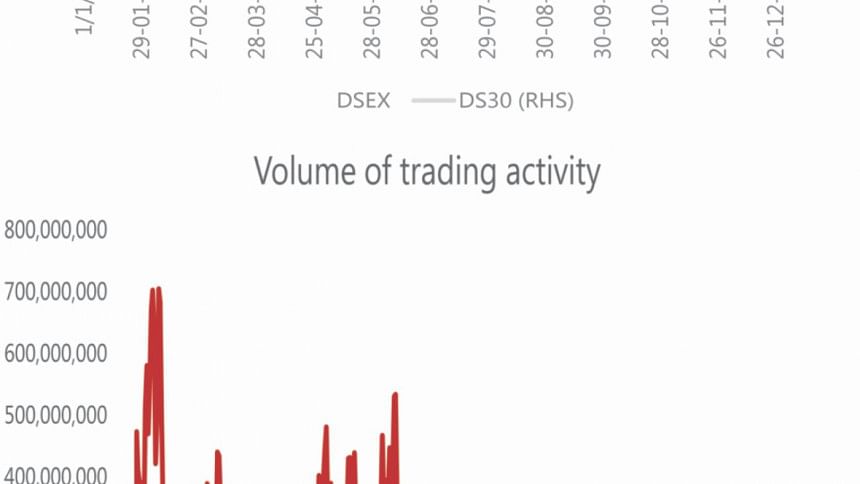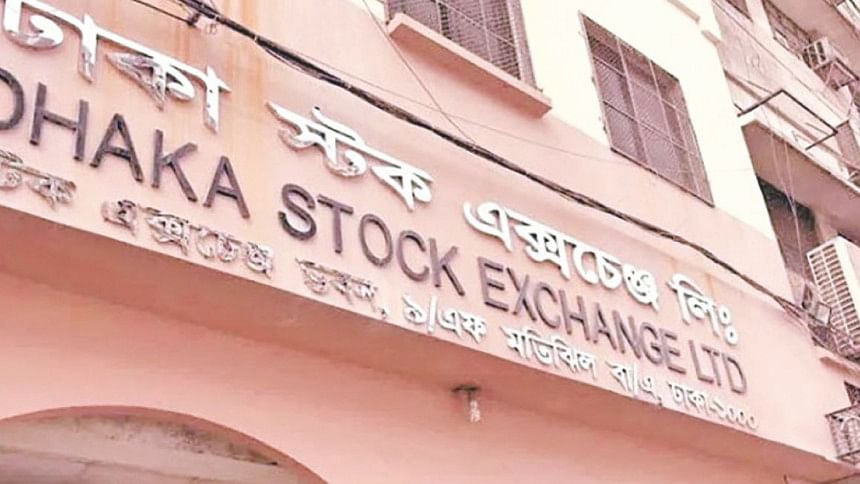The need to transform the capital market

In most market economies around the world, investors can typically choose between many financial assets to put their money in. The demand for different financial products arises from an elemental property of risky assets: uncertainty in payoffs. That is why investors are taught in Finance 101 that the recipe to avoiding financial disaster is to diversify their money. “Don't put all your eggs in one basket”—the golden rule of investing.
In our country however, investors do the exact opposite. They put all (or most) of their money in the hands of an ailing banking sector in mundane deposit schemes generating returns that cannot even outrun inflation.
To be sure, this is not really by choice. There are hardly other viable options. Herein lies the need for a modern and vibrant capital market boasting a plethora of financial assets which would allow investors to virtually insure against any future uncertainty while earning decent returns. If evidence from all across the globe is any guide, developing a capital market of such depth should rest on a three-dimensional strategy: (i) Strengthening the stock market; (ii) Building a bond market; and (iii) Designing a derivatives market.
STRENGTHENING THE STOCK MARKET
Sixty-three years since its inception, the day when we see a Dhaka Stock Exchange, where investors are gathering in masses to raise capital, still remains elusive. As we all know only too well, the recent and not-so-recent history is marred by two calamitous market crashes: one in 1996 and the other in 2010.
Both crashes had one thing in common. Stock prices were manipulated to exorbitant levels luring in naive investors who were hoping to make easy money. The idea of long-term investing after thorough assessment of a company's health was relegated to the backseat. Speculation became the mantra of stock investing.
So, a crash was inevitable. The ramifications were widespread: massive amounts of losses in household wealth, bankruptcies and unemployment that triggered huge waves of social discontent. Unscrupulous manipulators or gamblers got their way while the innocent suffered.
It was our hope that such traumatic episodes of financial, economic and social volatility would leave us at least with valuable lessons for the future, if nothing else. The former World Bank chief economist Paul Romer said long ago, “a crisis is a terrible thing to waste”, and it looks like that is exactly what we are doing. Almost a decade after our last stock market debacle, the market still remains in the grip of unethical gamblers while genuine investors scurry for cover at the first sign of trouble.
Take the performance of the stock market last year, for instance (shown in Chart 1). The general market index, DSEX, fell by 13.7 percent while the DS30, which is an index of 30 blue-chip companies representing around half of total market capitalization, went down by 17.6 percent. In other words, the supposedly high-quality companies dragged down the market. Not surprisingly, both value and volume of traded activity fell by fair amounts as well compared to 2017 (Chart 2), yet again undermining the overall loss of public confidence. The alarming characteristic of this correction was that we observed irrational episodes of rapid price hikes of fundamentally weak companies—or “junk stocks” in financial market lingo—while several “A” category stock prices fell despite offering dividends. Can this happen if the market is dominated by genuine investors seeking stocks of fundamentally-strong companies? The answer is a resounding “No”.
That said, it must be acknowledged that regulators have taken some steps in recent years which promises to bring some semblance of market stability. Largest of these steps was demutualisation of the Dhaka and Chittagong stock exchanges. It is fair to say that separating ownership, management, and trading rights of members and transforming the two stock exchanges into more professionally run organisations free of vested interests from brokers and dealers will go a long way towards ensuring long-term development.
Rising from this historic step is another benefit: the recent entrance of a Chinese consortium, comprising the Shanghai Stock Exchange and Shenzhen Stock Exchange, as strategic partner of DSE. Consequently, the DSE should become a more profitable organisation and receive foreign knowledge and expertise which can only change things for the better.
Another reform which promises to bring discipline and transparency is the Financial Reporting Act which was passed in 2015. Our hope is that passing the FRA means manipulation of financial statements will soon become a thing of the past.
It would be remiss not to mention that the regulator is also exploring steps to launch more advanced products like Exchange Traded Funds (ETF), Real Estate Investment Trusts (REIT) as well as Shariah Compliant Products.
Still, it is painfully true that these steps are far from enough to transform the equity market into an investment-hub commensurate with the economy's level of development. Over the years, the rise of big local and multinational corporations (MNC) in the manufacturing sector has led to a disconnect between the stock market and the real economy. So much so that the market did not even respond to a 14 percent expansion in manufacturing activity in fiscal year 2017-18, which fuelled GDP growth of 7.9 percent. No surprises there since these big corporations refuse to come to the market despite repeated appeals by regulators and various other stakeholders.
Paradoxically, we see many of these same MNCs listed in stock exchanges of neighbouring countries like India. So MNCs' argument that they do not have enough incentive to go public does not hold water. Further cuts in corporate tax rates for listed companies could be considered, though it may not change the picture all that much. That will leave authorities with one final option: mandatory listing of MNCs after they operate in Bangladesh for some years.
Closely related to this issue is the need for designing a more efficient Initial Public Offering (IPO) process. Good corporations cannot and should not use the excuse that the mechanics of going public is too cumbersome. For much of the last decade, the number of IPOs remained disappointing to say the least, averaging less than 15 per year. There is growing consensus among capital market professionals that the book-building method (BBM), which is essentially a mechanism for determining investor demand for shares during an IPO, suffers from several problems in Bangladesh's context. Problems with price discovery, overall complexity and lengthiness of the process has led to rising discontent to the extent that regulators have even hinted at discarding the BBM. Thus, an overall reassessment of the IPO process is the need of the hour.
Another undercurrent raising concern among economists and finance professionals is the supervision and governance structure of mutual funds. Indeed, professionally-managed wealth does hold a lot of promise, but regulators have not been able to raise investor confidence in this asset. And the regulator's recent advice to extend the maturity of 30 close-end mutual funds without consulting general investors will only hurt confidence, not build it.

BUILDING A BOND MARKET
The preceding section more or less captures much of the thinking surrounding the state of the stock market. But the matter doesn't end there because a vibrant stock market alone does not translate to a vibrant capital market. That brings us to the second of the three-dimensional strategy mentioned earlier: building a bond market.
Bangladesh's experience with debt instruments has been unpleasant at best. Come budget time, monetary policy meetings and other events, where the erudite of our public policy arena gather together, we hear visions of creating a strong and competitive bond market. But for all the talk, the appetite to do what needs to be done just has not been there.
What seems to have gone wrong in developing this market that could transform the face of Bangladesh's financial architecture for good? Perhaps a bit of historical context is in order.
Led by the vision of a private-sector driven economy, the Industrial Corporation of Bangladesh took the first steps to create a corporate debt market back in 1985. Soon after in 1987, investors saw the first public issue of a listed corporate debenture. The following years saw around a dozen more getting listed but as with most initiatives, problems propped up. Consequently, these initiatives lost momentum and any possibility of developing a vibrant bond market gradually started to fade. These problems may be summarised thus:
Many publicly traded debentures issued by well-known corporations through IPOs defaulted on their interest payment (coupon) as well as principal obligations. That the regulator was not able to nip these episodes in the bud only eroded public confidence in these instruments
All across the globe, corporate bonds are priced using government bonds as benchmark. Sadly, with a nascent government debt market lacking bonds of varying maturities, this could not be done effectively in Bangladesh. That there was no standard rating system to signal the quality of a bond exacerbated the problem.
Lack of regulations, policy support and adequate infrastructure to trade corporate bonds
High tax rates and cost of issuing debt instruments
Absence of a robust base of institutional investors (pension funds, mutual funds, merchant banks etc) only made things worse. After all ordinary citizens have historically only gone in to make quick money through rumour-based stock investments, while high transaction costs of trading bonds worked as an additional disincentive.
Considering Bangladesh's inflation levels and high GDP growth, absence of inflation-protected bonds and GDP-linked bonds did not help either.
Without any concrete push to address these challenges, it's no surprise that today Bangladesh's bond market is barely 8 percent of its GDP—one of the smallest in Asia, miles behind countries like India, Vietnam and China.
DESIGNING A DERIVATIVES MARKET
Make no mistake, this third step in our three-dimensional strategy is as important as the previous two if Bangladesh's history of stock market crashes and debt defaults is any indication. Recall that derivatives are primarily used to hedge or manage risk: be it exchange rate risk, interest rate risk, equity price risk, default risk etc. For firms and even households looking to manage currency risk, financing costs or credit exposures, these instruments are immensely valuable. For governments looking to issue debt, derivatives will help lower the cost of borrowing.
Small wonder that the world market for derivatives has expanded exponentially with rapid globalisation and international financial integration. To put it in perspective, the International Growth Center estimates that the collective gross market value of worldwide derivatives is over USD 27 trillion with a notional value exceeding a mind-boggling USD 640 trillion—that's about 8 times the value of world GDP if anyone is keeping count! And this colossal market is not just dominated by the industrialised world, big emerging economies like China and India have also made leaps and bounds over the years in creating an ecosystem conducive to trading some of the most sophisticated financial instruments on the planet.
Unfortunately, in Bangladesh the market for derivatives is almost non-existent. Nearly a decade has passed since Bangladesh saw its first financial derivative—a futures contract to manage exchange-rate risk between the Taka and the Dollar—for two leading garment manufacturers. And except for sporadic episodes of local and multinational corporations utilising futures and forward contracts to hedge exchange rate risk, we are yet to see any real appetite for more cutting-edge products like Swaps and Options. Though some critics of derivatives will remind us that it was products like Credit Default Swaps that spread the financial crisis of 2008, rest assured, that line of reasoning is similar to confusing a symptom with the underlying cause of a problem.
It was not that derivatives did not work well, it was actually that they worked too well. To the extent that investors became too complacent about risk and reduced due diligence. In other words, it was absence of sufficient regulations and lack of transparency in trading these instruments which led to the financial crisis of 2008. In response, former US President Barack Obama unveiled the Dodd-Frank Act, a sweeping overhaul of financial regulations which brought heightened scrutiny, transparency as well as checks and balances to trading products like derivatives to protect people's money.
The lesson, then, for Bangladesh is pretty clear. Even before the necessary financial infrastructure including electronic trading systems to trade derivatives is setup in DSE, policy-makers will have to carefully outline a series of regulations that governs this market judiciously and allow market participants to contain systemic risk.
But above all, authorities will have to educate the public about the pros and cons of these financial products—derivatives, bonds and stocks alike. They will also have to coordinate better among themselves: our stock market's patchy history should remind us that lack of coordination between the securities regulator and the central bank led to dire consequences. 2010 should be a painful reminder.
Let us accept that policymakers face daunting challenges in their road towards creating a vibrant capital market, but sometimes the first steps are the hardest and it is those few steps which can pave the way for a modern financial system in Bangladesh.

Sharjil Haque is a Doctoral student in Economics at the University of North Carolina, USA, and former Research Analyst, International Monetary Fund, Washington DC.

 For all latest news, follow The Daily Star's Google News channel.
For all latest news, follow The Daily Star's Google News channel. 



Comments